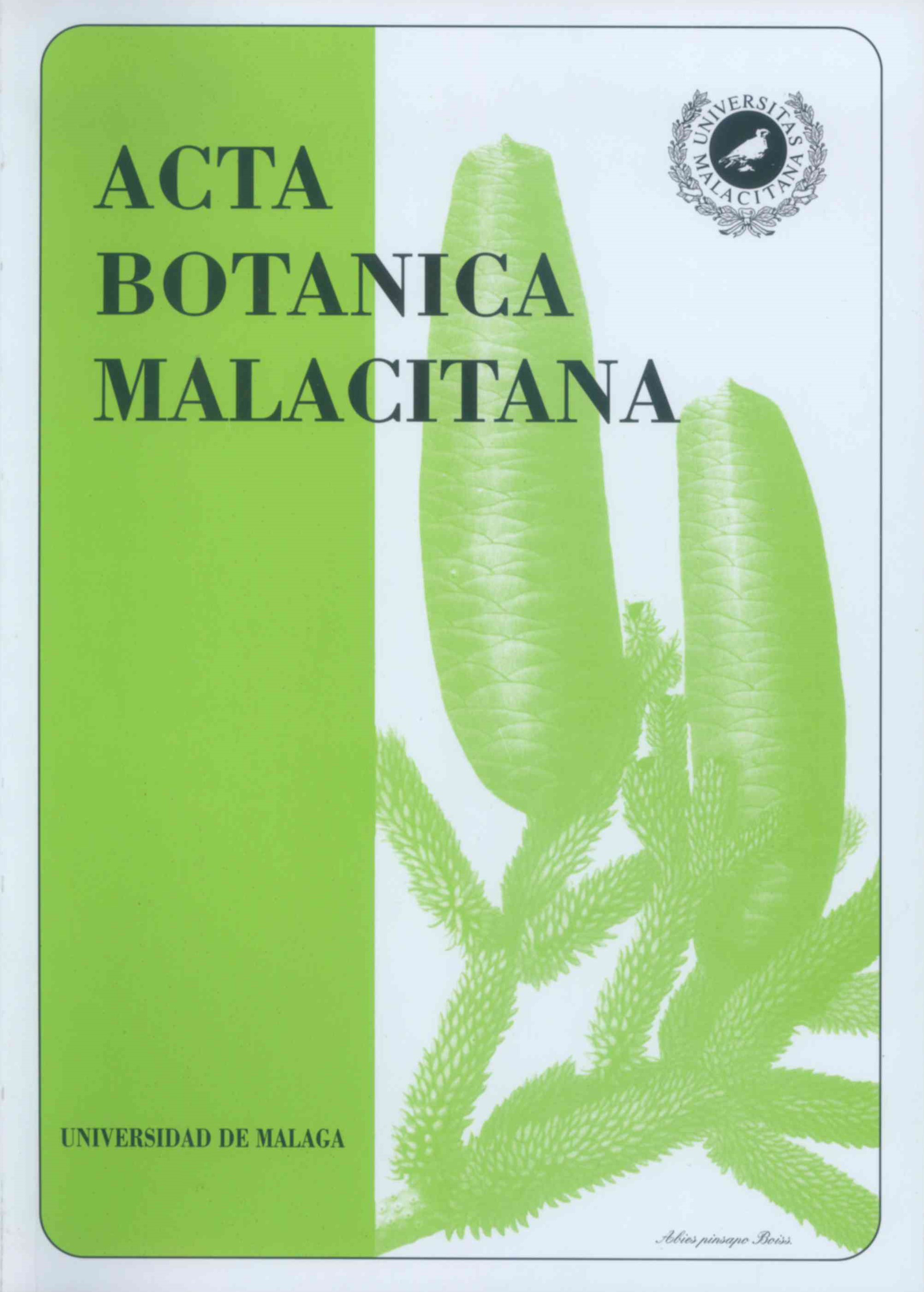Nectar production in scrublands of southern Spain (Andalusia)
DOI:
https://doi.org/10.24310/abm.v20i.8840Keywords:
Melissopalynogy, floral nectar, Andalusia, SpainAbstract
Nectar production in scrubland of southern Spain (Andalusia). The aim of this work is to evaluate the alimentary resources for the Apis mellifera. A study has been carried out about the nectar production of the most representative species of a scrubland in Sierra de Mijas (Málaga, Spain). The sugar production per flower species has been calculated based on the nectar volume and its sugar concentration and the sugar production per m2/species according to the flower production per m2/year. The nectar presence has been detected in 66 out of the 115 studied species and the sugar amount has been quantified in 49 of them.
Downloads
Metrics
References
BOLTEN, A.B., P. FEINSINGER, H.G. HERBERT y I. BAKER -1979- On the calculation of sugar concentration in flower nectar. Oecologia, 41: 301-304.
BOND, H.W. y W.L. BROWN -1979- The explotation of floral nectar in Eucalyptus incrassata by honeyeaters and honeybees. Oecologia, 44: 105-111.
BOSCH, J. -1992- Floral biology and pollinators of three co-occurring Cistus species (Cistaceae). Botanical Journal of the Linnean Society, 109(1): 39-55.
BRANDT, U. & G. GOTTSBERGER -1988- Flower phenology, pollinating insects and breeding systems in Cistus, Halimium and Tuberaria species in Portugal. Lagascalia, 15: 625-634.
CORBET, S.A. -1978- Bee visits and the nectar of Echium vulgare L. and Sinapis alba L. Ecol. Entomol., 3: 25-27.
CORBET, S.A., C.J.C. KERSLAKE, D. BROWN y N.E. MORLAND -1984- Can bees select nectarrich flowers in patch?. J. Apic. Res., 23(4): 234- 242.
CORBET, S.A., D.M. UNWIN y O.E. PRYS-JONES -1979a- Humidity, nectar and insect visits to flowers, with special reference to Crataegus, Tilia and Echium. Ecol. Entomol., 4: 9-22.
CORBET, S.A., P.G. WILLMER, J.W.L. BEAMENT, D.M. UNWIN y O.E. PRYS-JONES -19796- Post-secretory determinants of sugar concentration in nectar. Plant Cell and Environment, 2: 293-308.
CORBET, S.A., P.G. WILLMER, J.W.L. BEAMENT, D.M. UNWIN y O.E. PRYS-JONES -1979b- Post-secretory determinants of sugar concentration in nectar. Plant Cell and Environment, 2: 293-308.
CRUDEN, R.W. y S.M. HERMANN -1983- Studying nectar? Some observations on the art. En B. BENTLEY y T. ELIAS (eds.). The biology of nectaries., Columbia University Press. New York.
DEVESA, JA., J. ARROYO y J. HERRERA -1985- Contribución al conocimiento de la biología floral del género Lavandula L. Anales Jard. Bot. Madrid, 42(1): 165-186.
FERNANDEZ, C., A. MUÑOZ y J.A. DEVESA -1989- Las digitalis extremeñas. Vida apicola, 35: 27-33.
HERRERA, J. -1985a- Biología reproductiva del matorral de Doñana. Tesis Doctoral. Universidad de Sevilla.
HERRERA, J. -19856- Nectar secretion patterns in southern spanish mediterranean shrublands. Israel J. Bot., 34: 47-58.
HERRERA, J. -1987a- Biología reproductiva de algunas especies del matorral de Doñana. Anales Jard. Bat. Madrid, 44(2): 483-497.
HIDALGO, M.I y B. CABEZUDO -1994- Fenología y volumen de floración del matorral de la Sierra de Mijas (Málaga, SE España). Acta Bot. Malacitana, 19: 123-136.
HIDALGO, M.I. y B. CABEZUDO -1995- Producción floral en un matorral del S de España como base para su valoración melitopalinológica. Anales Jard. Bot Madrid, (en prensa).
INOUYE, D.W., N.D. FAVRE, J.A. LANUN, D.M. LEVINE, J.B. MEYERS, M.S. ROBERTS, F.C. TSAO y Y.Y. WANG -1980- The effects of nonsugar nectar constituents on estimates of nectar energy content. Ecology, 61(4): 992-997.
MUÑOZ, A. y J.A DEVESA -1987- Contribución al conocimiento de la biología floral del género Lavandula L. II. Lavandula stoechas L. subsp. stoechas. Anales Jard. Bot. Madrid, 44(1): 63- 78.
NUÑEZ, J. -1977- Nectar flow by melliferous flora and gathering flow by Apis mellifera ligustica. J. Insect Physiol., 23: 265-275.
ORTIZ, P. -1991- Melitopalinología en Andalucia Occidental. Tesis Doctoral. Universidad de Sevilla.
ORTIZ, P.L. -1994- The Cistaceae as food resources for honey bees in SW Spain. Journ. Apic. Research, 33(3): 136-144.
PERCIVAL, M. -1961- Types of nectar in Angiospermas. New Phytol., 60: 235-281.
PERCIVAL, M. -1961- Types of nectar in Angiospermas. New Phytol., 60: 235-281.
PERCIVAL, M. -1961- Types of nectar in Angiospermas. New Phytol., 60: 235-281.
PFLUMM, W. -1985- Influence of nectar-supply rate on the number of flowers visited by a honeybee on each collecting flight. Oecologia, 66: 207-210.
SHUEL, R.W. -1975- La producción de néctar. In DADANT et al. (eds) La colmena y la abeja melifera. Hemisferio Sur. Montevideo.
TALAVERA, S., J. HERRERA, J. ARROYO, P.L. ORTIZ y J.A. DEVESA -1988- Estudio de la flora apícola de Andalucía Occidental. Lagascalia, 15(extra): 567-591.
TALAVERA, S., P.E. GIBBS & J. HERRERA - 1993- Reproductive biology of Cistus ladanifer (Cistaceae) Pl. Syst. Ecol., 186: 123-134.
WEBER EL-GHOBARY, M.O. -1984- Observation of flowering, pollen, nectar and pollen loads, due to Apis mellifera in some mediterranean plants. Les colloques de e'INRA, 21: 245-250.
WILLMER, P.G. -1980- The effects of insect visitor on nectar constituents in temperature plants. Oecologia, 47: 270-277.
Downloads
Published
How to Cite
Issue
Section
License
Those authors who publish in this journal accept the following terms:
a. The authors will retain their copyrights and guarantee the journal the right of first publication of their work, which will be simultaneously subject to the Creative Commons Attribution-Non-commercial 4.0 license whose full text can be found at <http: // creative commons .org / licenses / by-nc / 4.0> that allows third parties to share the work as long as its author and its first publication are indicated, and as long as it is not for commercial purposes.
b. Authors may adopt other non-exclusive licensing agreements for the distribution of the version of the published paper (e.g., deposit it in an institutional telematic file or publish it in a monographic volume) provided that the initial publication in this journal be indicated.
c. Authors are allowed and recommended to disseminate their work through the Internet (e.g., in institutional telematic archives or on their websites) before and during the submission process, which can produce interesting exchanges and increase citations of the published work. (See The effect of open access)







1.png)
